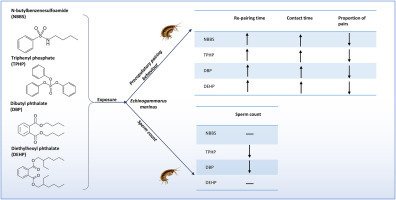Petits crustacés semblables aux crevettes, les gammares voient leurs comportements sexuels complètement chamboulés par la présence d'additifs plastiques dans l'eau. Certains refusent même d'avoir des rapports sexuels. Explications.
- Evaluation of precopulatory pairing behaviour and male fertility in a marine amphipod exposed to plastic additives - Environmental Pollution,
https://www.sciencedirect.com/science/article/pii/S0269749123019486
Highlights
- •
Pairing behaviour was impacted after 1 h exposure to plastic additives
- •
Environmentally relevant concentrations prolonged re-pairing time and contact time
- •
TPHP and DBP declined sperm count; NBBS and DEHP showed interindividual variability
- •
Pairing behaviour is a sensitive endpoint in ecotoxicological studies
Abstract
Plastics contain a mixture of chemical additives that can leach into the environment and potentially cause harmful effects on reproduction and the endocrine system. Two of these chemicals, N-butyl benzenesulfonamide (NBBS) and triphenyl phosphate (TPHP), are among the top 30 organic chemicals detected in surface and groundwater and are currently placed on international watchlist for evaluation. Although bans have been placed on legacy pollutants such as diethylhexyl phthalate (DEHP) and dibutyl phthalate (DBP), their persistence remains a concern.
This study aimed to examine the impact of plastic additives, including NBBS, TPHP, DBP, and DEHP, on the reproductive behaviour and male fertility of the marine amphipod Echinogammarus marinus. Twenty precopulatory pairs of E. marinus were exposed to varying concentrations of the four test chemicals to assess their pairing behaviour. A high-throughput methodology was developed and optimised to record the contact time and re-pair time within 15 min and additional point observations for 96 h.
The study found that low levels of NBBS, TPHP, and DEHP prolonged the contact and re-pairing time of amphipods and the proportion of pairs reduced drastically with re-pairing success ranging from 75% to 100% in the control group and 0%–85% in the exposed groups at 96 h. Sperm count declined by 40% and 60% in the 50 μg/l and 500 μg/l DBP groups, respectively, whereas TPHP resulted in significantly lower sperms in 50 μg/l exposed group. Animals exposed to NBBS and DEHP showed high interindividual variability in all exposed groups.
Overall, this study provides evidence that plastic additives can disrupt the reproductive mechanisms and sperm counts of amphipods at environmentally relevant concentrations. Our research also demonstrated the usefulness of the precopulatory pairing mechanism as a sensitive endpoint in ecotoxicity assessments to proactively mitigate population-level effects in the aquatic environment.
[Image] Graphical abstract



 Your new post is loading...
Your new post is loading...







